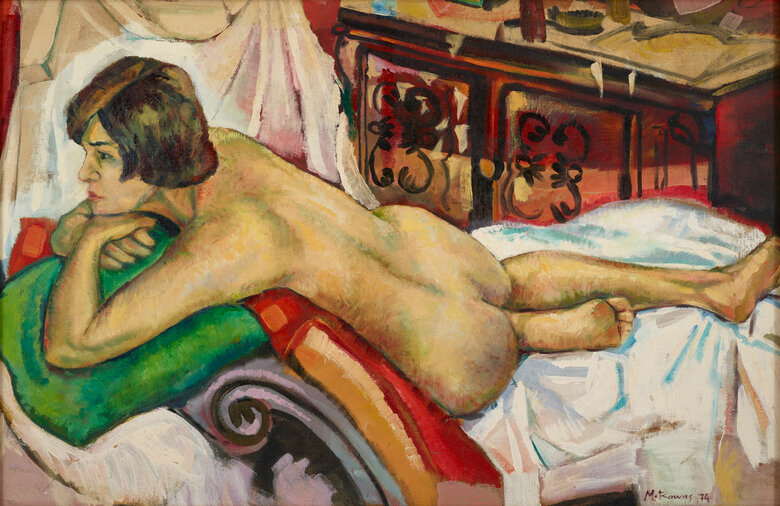Mohammad El Rawas’ Dolls at Play, 1993, is a lithography print that brings together a wide range of references in an exploration of the notion of innocence. For this piece, El Rawas used an offset printing press, which helps create high-quality reproductions that capture intricate details and subtle color variations. Before digitization, creating a lithograph print involved manually photographing the original artwork to create film negatives, with separate negatives made for each color. These negatives were transferred onto metal plates using a photomechanical process, and test proofs were carefully adjusted to ensure accurate color alignment and quality. The final edition was printed on fine art paper, with each color applied in separate runs through the press, followed by inspection, trimming, and the artist's signature.
In terms of references used for this work, El Rawas draws upon various ideas, which he combines for this piece. The girl in black and white in the foreground was taken from a book by Malek Alloula, titled The Colonial Harem – a collection of picture postcards of Algerian women who were exploited and made to pose for the camera during the French occupation of Northern Africa. French soldiers then sent these images to their friends and families in France. The girl is from one of these pictures, captioned "Scenes Et Types – Famille Arab," which shows her seated cross-legged on the ground beside her father and mother.
The background of the piece is from another work by El Rawas, titled The Scent of Autumn, 1991. Including this work within Dolls at Play, 1993, helped elucidate an aspect of the broader theme of this piece: the repeated images of the women in the background highlight the passing of time between the primary photograph of the girl in the front and the women in the back. The carvings at the bottom of the piece are from a book titled Antiquity: Forms and Styles. He placed these Ancient Egyptian (pharaonic) carvings upon stands to extenuate what the artist viewed as their marionette-type look, which in turn inspired the title of the work Dolls at Play.
The addition of the cartoonish cloth doll, floating at the central right side of the print, brings out the main theme of this piece, which is the notion of innocence. It asks the viewer to question the concept of innocence about the colonial harem fantasies of French occupation while also placing it in tandem with the idea of seasonal transformation, growth into womanhood, the passing of time, and what that could mean.
Signed and dated in English in the lower right.

-MohammadElRawas-Front.jpg)
-MohammadElRawas-Front.jpg)
-MohammadElrawas-The-Dream-of-wartime,1980-Front2.jpg)
-MohammadElrawas-The-Dream-of-wartime,1980-Front2.jpg)
-MohammadElRawas-ThePlayII,1981-Front2.jpg)
-MohammadElRawas-ThePlayII,1981-Front2.jpg)
-MohammadElRawas-Relatevily-Unknown,1981-Front2.jpg)
-MohammadElRawas-Relatevily-Unknown,1981-Front2.jpg)
-MohammadElRawas-Berytus,1980-Fron2.jpg)
-MohammadElRawas-Berytus,1980-Fron2.jpg)
-MohammadElRawas-Front.jpg)
-MohammadElRawas-Front.jpg)



